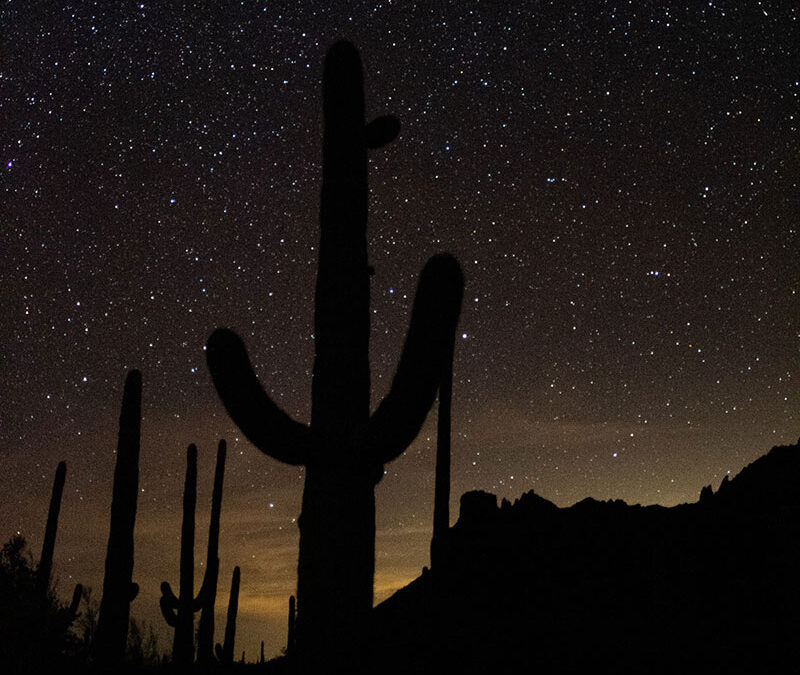Last night I sat watching the moon, barely gibbous at its zenith directly above, with a halo holding on about 15 degrees radius. Also the stars with Orion not far west of the moon. Wispy cloudy. I love desert nights and can sit for hours keeping an eye out on the sky. Also on the horizon and things that stand between. Not far in front of me stood a forty-foot saguaro with three arms visible in silhouette. I think of these cacti as the sequoia of the desert. Both stand out among their brethren as the biggest and most estimable and both often meet their ends from wind-throw, too vertically ambitious perhaps for their roots to sustain. Saguaro only lives a few hundred years at most whereas the sequoia counts his by the thousand and may never die of age. Both are admirable in every way and both have suffered at human hands—not by any means the only victims in Nature but distinctly poignant in my mind.
![]()
I am realizing that the lack of abundance out here—even if by desert standards this is a notably rich and diverse landscape—makes species stand out and feel more familiar than in forests. Several of them I feel have become friends: saguaro (of course), organ pipe, palo verde, ocotillo, cholla, creosote. There are plenty of others I don’t like excluding but I don’t know all the names and there has to be a limit. (I mentioned memory—I no longer look up the name of plants that interest me since I forget them by next year and sometimes by tomorrow.) These are not passing fancies; when I began spending time in deserts decades ago these same creatures captured me. Some of them I also find in other desert places, but some are only here, organ pipe for instance. It doesn’t matter what the appeal of each is and it may even be their union here, their collective spirit, that engages me, with of course their sentinel cactus wren, who happens to be calling now.
![]()
Generally, on principle, I avoid “nature trails.” All trails are nature trails and very often those labeled as such are artificial and “tame.” It’s a long-time prejudice and occasionally accurate, but I’ve gotten more tolerant and found many to be useful, primarily in terms of providing names to area flora. There’s one here, about a mile and a half long that begins in a small valley, ascends one side, descends back to valley floor farther to the north, ascends the opposite side and higher this time to a ridge overlooking Mexico a few miles away, and then returns to valley floor. I walk it at least once whenever I come. At this point in my physical life, it’s a mildly demanding hike and takes in most of what I cherish about Organ Pipe Cactus. But I believe the National Park Service has a problem (and not just the NPS; I’ve seen it appear on National Forest Service trails as well)—it is hung up on Nature as resource, as a collection of things to be used, as apparently mostly interesting only in terms of how it has traditionally been put to work by traditional people and now by us. Every little marker along the trail—in this case always pertaining to plants—tells how the limber bush, ocotillo, or whichever is in front of the sign was prepared by natives to eat, or for medicine, or for making tools, baskets, etc., or for building with. We don’t learn if they had nonutilitarian attitudes toward the flora or found particular spiritual significance in some; nor are there interesting vignettes about their response to rain or their placement on the ground in relation to other kinds of plants, why they flourish more in one area rather than another, how cooperative or competitive they are within the habitat, plant-animal relationships and what array of animals lives among the plants and who the primary pollinators are, how does desert mistletoe pick one type of shrub over another to parasitize, and so forth. Plants are as astonishing as animals and in recent times we are becoming more aware of their sentience and subterranean relationships. Wouldn’t this be more interesting than how they were prepared for breakfast? As far as I know, educational exhibits in the parks are prepared by staff within what’s called the Interpretation Department. I volunteered in Yosemite Valley for several years during the ought’s, always within “Interp,” (a name I thought odd but was intended to convey that natural thing were being interpreted to the public rather than taught or educated about; I don’t know why that mattered), and I don’t remember the issue of exhibit content ever being discussed. Which was not surprising since as a bureaucracy it was a top-down operation and thus ours was not to reason why…I don’t know why the relentless utilitarianism infuses government “resource” departments, except that since they are called “resource” departments that may set the tone. Staff in these departments don’t speak of forests and rivers; they speak of resources or sometimes wildlife resources, forest resources, etc. If people working in these departments are concerned about human abuses of the natural world, which they are, this does not seem to me the best language for conveying respect for that world.
Photo by Madalyne Staab on Unsplash


